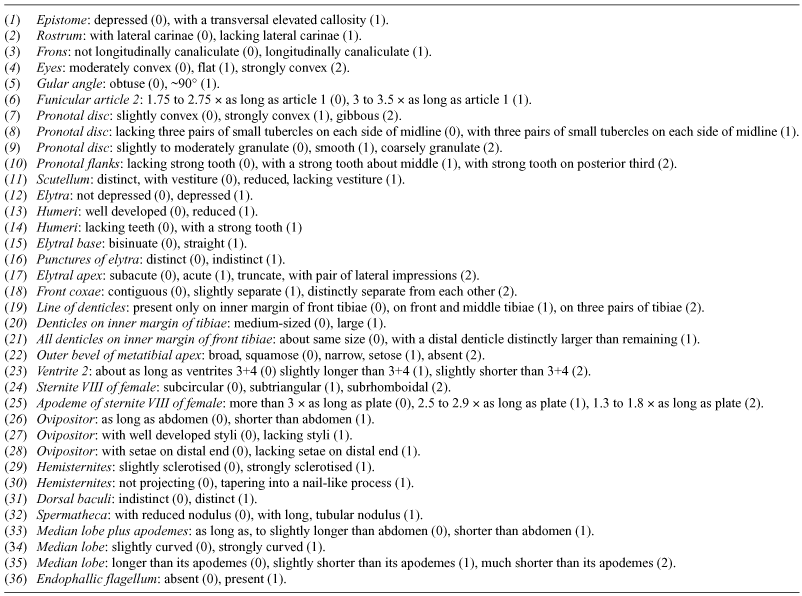Taxonomic revision and cladistic analysis of Teratopactus Heller (Coleoptera : Curculionidae)
M. Guadalupe del Río A , Analía A. Lanteri A C and Jerson V. C. Guedes BA División Entomología, Museo de La Plata, Paseo del Bosque s/n, 1900 La Plata, Argentina.
B Laboratorio de Manejo Integrado, Universidade Federal de Santa María, RS, Brazil.
C Corresponding author. Email: alanteri@fcnym.unlp.edu.ar
Invertebrate Systematics 20(5) 585-602 https://doi.org/10.1071/IS05047
Submitted: 12 October 2005 Accepted: 14 August 2006 Published: 12 October 2006
Abstract
Teratopactus Heller (Entiminae : Naupactini) is a broad-nosed weevil genus widespread in South America. This first taxonomic revision of the genus includes seven species: T. capucinus (Perty) (type species; syn. T. senex (Boheman)); T. elegans (Lucas), comb.nov.; T. gibbicollis (Boheman); T. nodicollis (Boheman) (syn. T. angulicollis (Lucas), T. paulanus (Fonseca & Autuori), T. serripes (Boheman), and T. perpastus (Boheman), syn. nov.); T. retusus (Boheman); T. tuberculatus (Arrow); and T. vittatus (Mannerheim), comb.nov. All species except T. tuberculatus have a strong ovipositor lacking styli, T. elegans, T. nodicollis and T. vittatus show well developed humeri bearing a strong tooth and T. retusus, T. capucinus and T. gibbicollis are characterised by a strongly gibbous pronotum and reduced humeri. Teratopactus nodicollis is the most variable and widespread species (Argentina, Brazil, Bolivia, Paraguay and Uruguay), T. tuberculatus and T. elegans range through Brazil and Paraguay and the remaining species are endemic to Brazil. The first cladistic analysis of the genus Teratopactus plus two outgroups, using 36 morphological characters, established synapomorphies and revealed relationships between the species in a single cladogram with the following topology: (T. tuberculatus ((T. elegans (T. nodicollis– T. vittatus)) (T. retusus (T. capucinus–T. gibbicollis)))).
Additional keywords: cladistics, Naupactini, systematics, weevils.
Acknowledgments
We wish to express our appreciation to all the specialists and curators who lent us specimens for study and/or facilitated the examination of material in their care; to the specialist Juan José Morrone for the critical reading of the manuscript, to the anonymous referees and editors for improving this contribution and to the ‘Consejo Nacional de Investigaciones Científicas y Técnicas’ (CONICET), Argentina, for its continuous support.
Blackwelder R. E.
(1947) Checklist of the Coleopterous insects of Mexico, Central America, the West Indies, and South America. Part 5. Bulletin of the United States Natural History Museum 185(i–iv), 765–925.
[verified September 2006].
Heller K. M.
(1921) Nuevos curculiónidos de la Argentina. Anales de la Sociedad Científica Argentina 91, 19–35.
[verified September 2006].
Scataglini M. A.,
Lanteri A. A., Confalonieri V. A.
(2005) Phylogeny of the Pantomorus-Naupactus Complex based on morphological and molecular data (Coleoptera: Curculionidae). Cladistics 21, 131–142.
| Crossref | GoogleScholarGoogle Scholar |

Thompson R. T.
(1992) Observations on the morphology and classification of weevils (Coleoptera, Curculionoidea) with a key to major groups. Journal of Natural History 26, 835–891.
| Crossref |

van Emden F. I.
(1944) A key to the genera of Brachyderinae of the world. Annals and Magazine of Natural History 11, 503–532.


|


